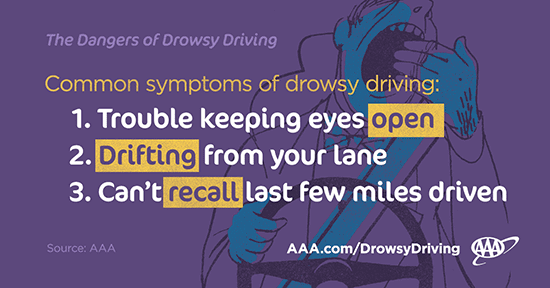AAA study shows drowsy driving crashes are eight times higher than federal estimates
BOISE – (February 8, 2018) – The AAA Foundation for Traffic Safety’s new study on drowsy driving – the most extensive of its kind – finds that the percentage of crashes involving driver fatigue is eight times higher than current federal estimates.
While the National Highway Traffic Safety Administration estimates that drowsiness is a factor in 1 to 2 percent of all crashes, AAA’s new study shows that the problem is much worse – a shocking 9.5 percent of all crashes, and 11 percent of the crashes that resulted in significant property damage, involve sleepy drivers.
In 2016, an estimated six percent of Idaho’s single-vehicle crashes were caused by drivers that nodded off. But that’s likely just the tip of the iceberg.
“When drivers get tired, the symptoms can be very subtle,” says AAA Idaho spokesman Matthew Conde. “It can be hard for law enforcement to determine that drowsy driving has occurred after a crash; some drivers are reluctant to say that they fell asleep behind the wheel.”

The Centers for Disease Control and Prevention note that 35 percent of U.S. drivers sleep less than the recommended minimum of seven hours daily. AAA’s previous research also found that skipping two to three hours of sleep can more than quadruple the risk of being in a crash and lead to behavior that closely resembles drunk driving.
In a recent AAA survey, nearly all drivers say that drowsy driving is a serious safety threat, yet 3 out of 10 respondents admitted to driving when they were so tired they had a hard time keeping their eyes open on at least one occasion in the past month.
“Some drivers possess an air of invincibility when it comes to their sleeping habits,” Conde said. “But in the long run, no one is immune from the dangerous effects of sleep deprivation.”
Tips to avoid drowsy driving
AAA offers the following advice to reduce the chances of driver fatigue:
- Travel during times of the day when you’re normally awake
- Don’t eat a heavy meal before driving
- Avoid television, video games, or social media that will tempt you to stay up too late
- Complete travel plans and pack your bags hours or even days before your trip. That way, you won’t stay awake worrying about last-minute details
- Schedule a break every two hours or every 100 miles when taking longer trips
- Travel with an alert passenger and take turns driving
“Prescription medications can also have a major impact on driver alertness,” Conde said. “Roadwise Rx is a AAA site that explains how various prescriptions interact with each other, along with any impact on safe driving.” For more information, go to roadwiserx.com.
AAA’s new drowsy driving study includes an unprecedented analysis of in-vehicle dash-cam video from more than 700 crashes. By reviewing the minutes leading up to the crash on a frame-by-frame basis, researchers used scientific measures to determine that an unexpectedly high number of drivers had their eyes closed in the moments before the collision.
For purposes of the study, motorists were classified as drowsy if the driver’s eyes were closed in 12 percent or more of the video frames in the three-minute or one-minute period preceding the crash.
“It’s important for drivers to avoid placebos like drinking caffeine, rolling down the window, or singing along to music as methods to fight drowsiness,” Conde said. “The only medicine that really works when you’re tired is to pull over and get some sleep.”

